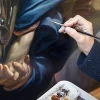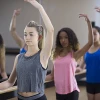92 careers found.
Chefs plan and organise the preparation and cooking of food in a number of settings.
Clothing patternmakers produce master patterns from designs. They work closely with designers, interpreting their sketches to develop a style that can be achieved by the company's equipment and staff, and that fits the image of the company's label.
Confectioners mix, shape and cook sweeteners and other ingredients to produce confectionery, including chocolate, toffee and other lollies.
Conservators plan, organise and undertake the preservation and conservation of materials and objects in private, public and community collections, including libraries, archives, museums, art galleries, art centres, and historical and archaeological sites. Conservators specialise in a range of areas, including paper, paintings, photographs, social and cultural artefacts, bookbinding and archives, furniture, archaeological materials, buildings and historic sites, outdoor sculpture and large technology objects, textiles and preventative conservation.
The range of duties carried out by cooks varies depending on where they work. In hotels, clubs, restaurants and takeaway food outlets, cooks often specialise in preparing and cooking a particular type of food (fried chicken, pizza or barbecued meat, for example). They may also specialise in national cuisine (such as Thai, Vietnamese, French or Italian). Other specialisations include entrees, desserts, international and bakery cooking.
Copywriters interpret how a potential market will react to an advertising proposal, and write material to advertise products or services. With experience, and sometimes further training, copywriters may become creative directors in advertising agencies where they supervise the work of staff in the design area, or advertising managers in retail or manufacturing firms.
A craftsperson designs, makes and repairs objects that have both functional and artistic qualities, working with wood, metal, glass, leather, ceramics, textiles and other materials.
Cultural heritage officers are involved in the identification, assessment, conservation and interpretation of places and objects that have cultural heritage value.
Dancers are performers who entertain audiences by dancing as soloists, with a partner or as members of a group. There are many styles of dance, including ballet, contemporary, Aboriginal and Torres Strait Islander, folk, jazz, ballroom and tap. Dancers may perform using a variety of styles, or they may specialise in one particular dance style.
Editors read and correct written material for publication, draft and implement editorial policy, decide on the content of publications or news items and manage the production of publications and the staff involved, depending on the position they hold.
Entertainers captivate, amuse or thrill an audience with dramatic, musical and other performances. They may perform a variety of tasks depending on their area of expertise.
Fashion coordinators arrange and supervise the marketing of fashion clothing for manufacturing houses, textile firms and retail stores.
Fashion designers plan and develop new clothing and accessory styles by creating original designs or by adapting fashions to suit local conditions and trends. They fabricate sample garments based on these designs.
Film and television camera operators set up, position and operate equipment in studios or on location to photograph or record people, events and scenes. Film camera operators use 16mm and 35mm film cameras or digital video for motion pictures, whereas television and video camera operators use cine-electronic television or digital video and video cameras for direct telecast and recording.
Film and television editors edit and assemble films and videos from raw, unedited footage ('dailies' or 'rushes'), taking into account the mood, pace and climax of films or television productions.






